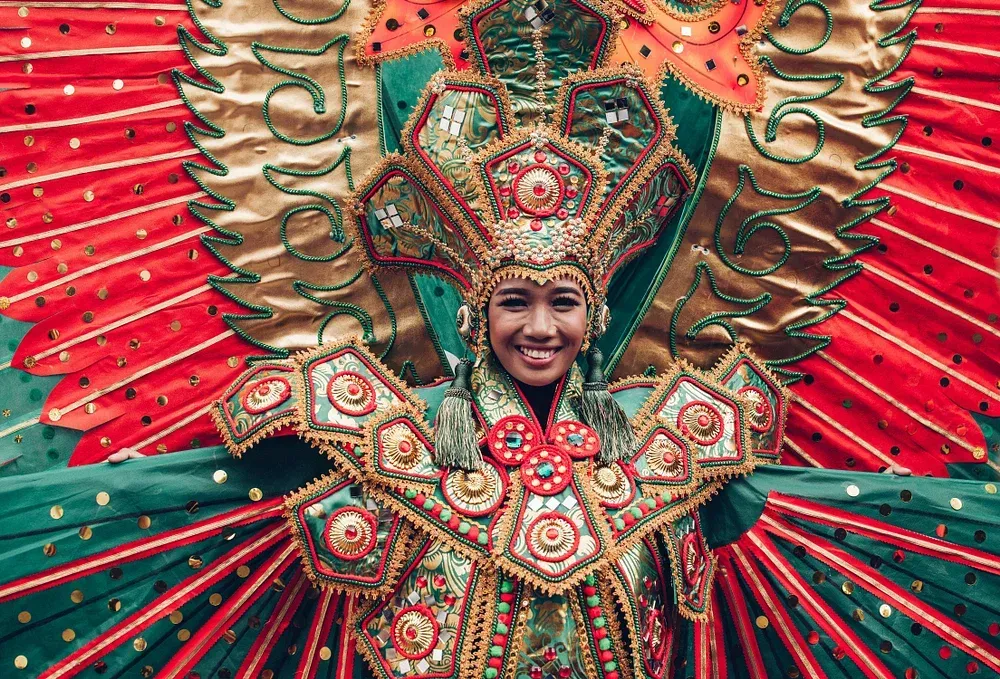⭕ SMART: 098 5973 7798 ⭕ GLOBE: 091 5874 9128 ⭕LANDLINE: 034 466 4554
Ati-Atihan Festival Review
Chapter 1: The Island of PanayButton
Ati-Atihan, often referred to as the "Mother of All Philippine Festivals," is deeply rooted in the history and culture of the island of Panay in the Philippines. Panay, located in the Western Visayas region, is known for its diverse and rich cultural traditions.
The festival finds its home in Kalibo, the capital of Aklan province, which is situated on the northwestern coast of Panay. Kalibo's history is intertwined with Ati-Atihan, as it was here that the festival took root and flourished into the vibrant celebration it is today.
Chapter 2: The Origin of Ati-Atihan
The origins of Ati-Atihan can be traced back to the early 13th century when the island of Panay was divided among various Malay tribal groups. Among these groups were the Atis, an indigenous people who inhabited the island long before the arrival of the Malays.
According to legend, the Atis were dark-skinned inhabitants who lived in the lush forests and coastal areas of Panay. They were known for their resilience and resourcefulness, skills honed by their ability to thrive in the island's challenging environment.
Chapter 3: The Arrival of the Malays
The peaceful coexistence between the Atis and the Malays changed with the arrival of the Malays in the 13th century. The Malays, who were skilled in agriculture, introduced new crops and technologies to the island, which led to increased agricultural production and population growth.
As the Malay tribes settled and expanded their territories, they came into contact with the Atis. The Atis were gradually assimilated into the Malay culture, resulting in a blending of traditions and customs. This cultural fusion laid the foundation for the Ati-Atihan Festival.
Chapter 4: The Festival's Religious Roots
While Ati-Atihan's origins are deeply rooted in indigenous cultures, the festival acquired a religious significance over time. It was during the Spanish colonial period that the festival was aligned with Christianity, particularly the devotion to the Santo Niño or the Child Jesus.
Legend has it that in the early 13th century, a group of Malay datus, or chieftains, led by Datu Puti, arrived in Panay to escape the tyranny of the Datu Makatunaw. They brought with them an image of the Santo Niño, which is believed to be the same image that is venerated today in the Kalibo Cathedral.
Chapter 5: The Transformation of Ati-Atihan
The fusion of indigenous and Malay traditions, combined with the introduction of Christianity, gave birth to a unique and vibrant celebration that we now know as Ati-Atihan. The festival evolved into a grand procession where devotees and revelers painted their faces with soot or wore Ati-inspired costumes to emulate the dark-skinned Atis.
In the midst of dancing, chanting, and drumming, the devotees paid homage to the Santo Niño, making Ati-Atihan a fusion of faith and festivity. The festival served as a way for the people of Kalibo to express their devotion and gratitude to the Santo Niño while celebrating their cultural heritage.
Chapter 6: Ati-Atihan in Modern Times
Throughout its long history, Ati-Atihan has endured colonial rule, wars, and natural disasters. Despite these challenges, the festival has continued to thrive and evolve. It has expanded beyond Kalibo and has become a national and even international attraction.
Today, Ati-Atihan is celebrated not only in Kalibo but also in various parts of the Philippines, each with its unique interpretations and traditions. The festival's significance has broadened to encompass themes of unity, camaraderie, and cultural pride.
Chapter 7: The Modern Ati-Atihan Festival
The modern Ati-Atihan Festival is a grand spectacle characterized by colorful costumes, exuberant street dancing, and a lively atmosphere. Participants, known as "Atis," paint their faces with soot or wear elaborate costumes to mimic the appearance of the indigenous Ati people.
The festival's centerpiece is the Santo Niño, which is paraded through the streets of Kalibo amidst the rhythmic beat of drums and the joyful chants of devotees. The streets come alive with vibrant colors, music, and dance, creating an electrifying atmosphere that draws locals and tourists alike.
Chapter 8: Cultural Significance and Identity
Ati-Atihan is not just a festival; it is a cultural treasure that underscores the resilience and adaptability of the Filipino people. It represents the ability of a diverse nation to celebrate its heritage while embracing change and transformation.
The festival serves as a reminder of the Philippines' precolonial roots and its subsequent integration of foreign influences, particularly Spanish culture. Ati-Atihan embodies the complex tapestry of Filipino identity, where tradition and innovation coexist.
Chapter 9: Challenges and Preservation
Preserving Ati-Atihan's authenticity and cultural significance in the face of modernization and commercialization is an ongoing challenge. As the festival gains popularity, there is a delicate balance between accommodating tourism and preserving the integrity of the celebration.
Efforts are underway to ensure that Ati-Atihan remains rooted in its cultural and religious origins. Local authorities and cultural organizations are working to educate participants and visitors about the festival's history and significance.
Chapter 10: The Legacy of Ati-Atihan
Ati-Atihan is more than just a festival; it is a living testament to the enduring spirit of the Filipino people. It is a celebration of faith, culture, and identity that has transcended centuries and continues to unite generations. As long as Ati-Atihan lives on, it will remain a vibrant reminder of the Philippines' rich history and the enduring legacy of the Ati people. It is a celebration of transformation, unity, and cultural pride that will continue to captivate the hearts and souls of those who participate in its joyous rhythms and vibrant traditions.
The Ati-Atihan Festival is a lively and colorful celebration that originated in Kalibo, Aklan, Philippines. Its history can be traced back to a convergence of cultural, historical, and religious influences, ultimately giving rise to this vibrant and unique event.
The festival's roots can be attributed to the island's early inhabitants, the Ati people, who were of Negrito descent and regarded as the indigenous people of Panay. The name "Ati-Atihan" itself comes from the word "ati," which refers to the native people, and "atihan," which means "to make like Atis" or "to become like Atis." This signifies a form of imitation or emulation of the indigenous culture.
The festival gained greater significance with the arrival of Spanish explorers and Christian missionaries in the Philippines during the 16th century. Catholicism was introduced to the islands, and the Spanish missionaries sought to incorporate traditional beliefs and practices into the new religion. The story of the Ati-Atihan Festival is often associated with the Santo Niño (Child Jesus), a highly revered religious icon.
Legend has it that in the early 1200s, a group of Malay datus (chiefs) fleeing the oppressive rule of the Sultanate of Borneo sought refuge in the island of Panay. They negotiated with the indigenous Ati tribe for land to settle. As a gesture of goodwill and gratitude, the datus offered gifts to the Atis, including an image of the Santo Niño. This image eventually became a symbol of unity between the newcomers and the indigenous people.
The festival's modern iteration as we know it today is a blend of these historical events and cultural influences. The Ati-Atihan Festival is characterized by its vibrant street dancing, where participants paint their bodies with dark pigments to imitate the appearance of the Ati people. They wear traditional indigenous clothing and dance in the streets to the beat of drums and other instruments. The Santo Niño is prominently featured throughout the celebration, with devotees often carrying images of the Child Jesus as they dance and parade.
The Ati-Atihan Festival typically takes place in January, with Kalibo's streets transformed into a joyful spectacle of colors, music, and dance. It is not only a religious event but also a celebration of cultural heritage and unity, emphasizing the harmony between the different cultural and religious influences that have shaped the Philippines. In conclusion, the Ati-Atihan Festival is a fascinating fusion of indigenous heritage, Spanish colonization, and Catholic traditions. It showcases the resilience of cultural traditions and their ability to adapt and evolve over time. The festival continues to captivate and unite people, both locals and visitors, as they come together to honor history, celebrate faith, and revel in the rich tapestry of Philippine culture.

Origin: The Ati-Atihan Festival originated in Kalibo, Aklan, Philippines.
Ati People: The festival is named after the Ati people, the indigenous inhabitants of Panay Island.
Cultural Imitation: The name "Ati-Atihan" means "to make like Atis" and signImageifies the emulation of Ati culture.
Historical Significance: The festival's roots date back to the arrival of Spanish explorers and missionaries in the 16th century.
Santo Niño: The festival is closely associated with the Santo Niño (Child Jesus), an important religious icon in Philippine Catholicism.
Legend of Unity: Legend has it that Malay datus fleeing Borneo gifted an image of the Santo Niño to the Ati people, symbolizing unity between cultures.
Body Paint: Festival participants paint their bodies with dark pigments to mimic the appearance of the Ati people.
Indigenous Clothing: Participants wear traditional indigenous clothing and adornments during the festival.
Street Dancing: Ati-Atihan is known for its vibrant street dancing, where participants dance to the beat of drums and other instruments.
Devotion and Parades: Devotees carry images of the Santo Niño as they dance and parade through the streets.
Celebration of Unity: The festival is a celebration of cultural heritage and the harmony between different cultural and religious influences.
Time of Celebration: Ati-Atihan is typically celebrated in January, attracting both locals and tourists.
Cultural Resilience: The festival showcases the adaptability and evolution of cultural traditions over time.
Rich Tapestry: Ati-Atihan highlights the diverse and rich tapestry of Philippine culture.
Joyful Spectacle: Kalibo's streets come alive with colors, music, and dance during the festival.
Religious and Cultural Significance: Ati-Atihan is not only a religious event but also a celebration of cultural identity and history.
What Are The Main Reasons To Celebrate The Ati-Atihan Festival
Cultural Fusion: Ati-Atihan is a vibrant fusion of indigenous Ati culture, Spanish influence, and Catholic traditions, creating a unique and captivating celebration.
Historical Roots: The festival's history can be traced back to the arrival of Spanish explorers and the blending of local traditions with Catholicism, resulting in a rich tapestry of customs.
Symbolism of Unity: Ati-Atihan symbolizes the unity between different cultural groups, as demonstrated by the legend of the Santo Niño's gift and the subsequent festivities.
Body Paint and Attire: Participants cover themselves with dark pigments, emulating the appearance of the Ati people, and wear traditional indigenous clothing, creating a visually striking and culturally immersive experience.
Street Dancing: The heart of the festival lies in its energetic street dancing, where locals and tourists alike join in the rhythmic dance, accompanied by the beat of drums and lively music.
Devotion and Spirituality: Ati-Atihan is both a religious and cultural event, with devotees carrying images of the Santo Niño and demonstrating their faith through dance and parades.
Community Involvement: The festival fosters a sense of community and belonging, as individuals of all ages and backgrounds come together to celebrate their shared heritage.
Tourist Attraction: Ati-Atihan draws visitors from around the world who seek to experience the colorful spectacle and immerse themselves in the vibrant Philippine culture.
Local Traditions: Amidst the festivities, various local rituals and customs are showcased, allowing attendees to connect with the region's heritage on a deeper level.
Culinary Delights: The festival is an opportunity to savor traditional Filipino dishes and delicacies, enhancing the cultural experience through a diverse array of flavors.
Economic Impact: Ati-Atihan contributes significantly to the local economy, boosting tourism, promoting local businesses, and creating job opportunities.
Preservation of Heritage: The festival plays a vital role in preserving and passing down cultural traditions from one generation to the next, ensuring their continued relevance and significance.
Educational Value: Ati-Atihan offers insights into the history, folklore, and evolution of Philippine culture, making it a valuable educational experience for both locals and visitors.
Sense of Pride: The festival instills a sense of pride and identity among the people of Kalibo and the wider Philippines, reinforcing the importance of cultural heritage.
Global Impact: Beyond its local significance, Ati-Atihan serves as a shining example of cultural diversity and celebration, inspiring similar events and fostering intercultural understanding worldwide.

Our Conclusion On The Ati-Atihan Festival
The Ati-Atihan Festival stands as a vibrant testament to the enduring spirit of cultural heritage and unity. Emerging from the convergence of indigenous Ati culture, Spanish colonization, and Catholic traditions, this lively celebration in Kalibo, Aklan, Philippines, holds a special place in the hearts of both locals and visitors.
The festival's roots in the legend of the Santo Niño and the gesture of unity between different cultures exemplify the power of symbols to bridge divides and foster understanding. Through its spirited street dancing, colorful body paint, and the joyous parade of devotees, Ati-Atihan embodies the collective celebration of history, faith, and cultural diversity.
As the streets of Kalibo come alive each January, the Ati-Atihan Festival serves as a vivid reminder that the passage of time can enrich and reshape traditions, while also preserving the essence of their origins. This celebration continues to captivate the imagination, inviting everyone to participate in the rhythmic dance of cultures coming together, harmonizing in a symphony of shared experiences and collective joy.


